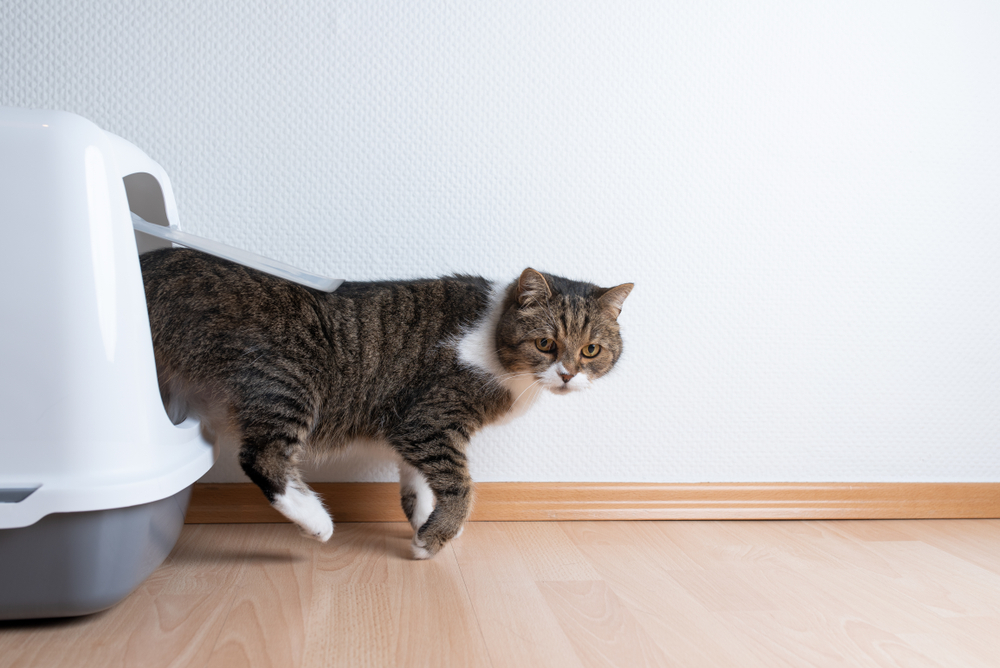Your newly adopted cat is sitting in the middle of your living room, staring at you. The tip of his tail taps lightly on the carpet. The pride you felt when you rescued them from certain homelessness has worn off. As you meet their gaze, your heart sinks. It’s as if your cat is asking, “What now?”
Anyone with a cat can attest to their seemingly mysterious lives. Who hasn’t wondered what goes on behind those intense eyes? As a Cat Friendly Practice, Burlington Veterinary Center can help you understand your pet. By considering natural feline behavior and instincts, and making a few simple alterations to their environment, you can easily meet your cat’s needs for nine lives’ worth of health and happiness.
#1: Engage the feline mind
Cats are natural predators, and despite domestication, they retain their strong instincts, which influence a large portion of cat behavior and care. Anyone who has watched kittens at play has seen predatory movements and actions. Owners should provide a safe outlet for their cat’s need to stalk, chase, pounce, and—sometimes—destroy, by offering appropriate toys that mimic real prey. A wide selection of toys with erratic, unpredictable movements are available, and some DIY options require only a little creativity. All cats have their preferences, so be patient, because you are learning and building a bond each time.
#2: Meet your cat’s social needs
You are a key part of your cat’s environment. A cat’s independent nature means they are often misinterpreted as aloof or distant, which can result in less attention from their owners. This is unfortunate, because cats do require and desire social interaction. However, cats come with a few specific rules—namely:
- They must be allowed to remain in control of the situation.
- They should be encouraged to solicit affection and play, but never forced to stay or participate.
- They require attention according to their individual style. Some cats enjoy being held and snuggled, while others feel trapped and seek escape. Stay in your cat’s comfort zone, and let them leave if they choose.
#3: Ditch the cat food bowl
Eating from a bowl every day is boring when you’re a born hunter. Fortunately, many food-dispensing toys for cats that allow them to engage in exploratory and predatory behaviors to score their meals are available. From puzzles that disperse dry food at random, to motorized mice that require a game of chase, your cat can have a new challenge every day. For cats who prefer wet food, filling hollow toys with canned diets provides a new way of eating. Begin with easy toys to help your cat understand how to “win,” and increase the difficulty gradually. The increased physical activity from eating meals in food toys is an additional benefit.
#4: Learn to look up, and in!
Cats love elevation and often gravitate to the highest perch in a room. A cat without access to a raised hiding place may feel vulnerable and exposed—and may end up selecting your antique armoire by default. Cats may be predators, but they are also historically prey for larger species, so their need to keep a lookout is two-fold. Cat furniture, such as tall perches and trees, provide cats with not only a fantastic view, but also a feeling of safety, knowing they can rest without threat of danger. Consider your cat’s love of heights and desire to hide when examining their living space. Do they have several safe options? Are their spaces wide enough to curl up for a nap? Cats also have a desire to hide, and usually prefer to sleep in enclosed box-style dens or beds. An unused cardboard box can work well! Bonus points if the den is elevated or part of a cat tree. Pay attention to your cat’s behavior to learn his preferences.
#5: Respect your cat’s need for privacy

While their litter box is a private matter for the dignified feline, you certainly should give their needs some thought. For complete cat comfort and health, follow the “one box per cat, plus one” rule that not only provides easy access, but also reduces bullying and competition for resources in multi-cat or pet households. Litter boxes should be placed in quiet, low traffic areas if possible, and in separate rooms. Food, water, and resting places should not be near the litter box. Clean the box at least once a day.
As a rule, cats tend to prefer a roomy box with space to turn around and dig, but some prefer the safety and privacy of a covered box. The wide range of cat litter available can be overwhelming, and finding the style most suitable for your cat and for you may take some research.
Understanding your new cat can be confusing at times. Cats are an already mystifying species, and adding on the complexities of individual preference and personality may leave you with a lot of questions. As a Cat Friendly Practice, Burlington Veterinary Center is dedicated to strengthening the bond between you and your cat. Contact us today, and let us know how we can help.







Leave A Comment